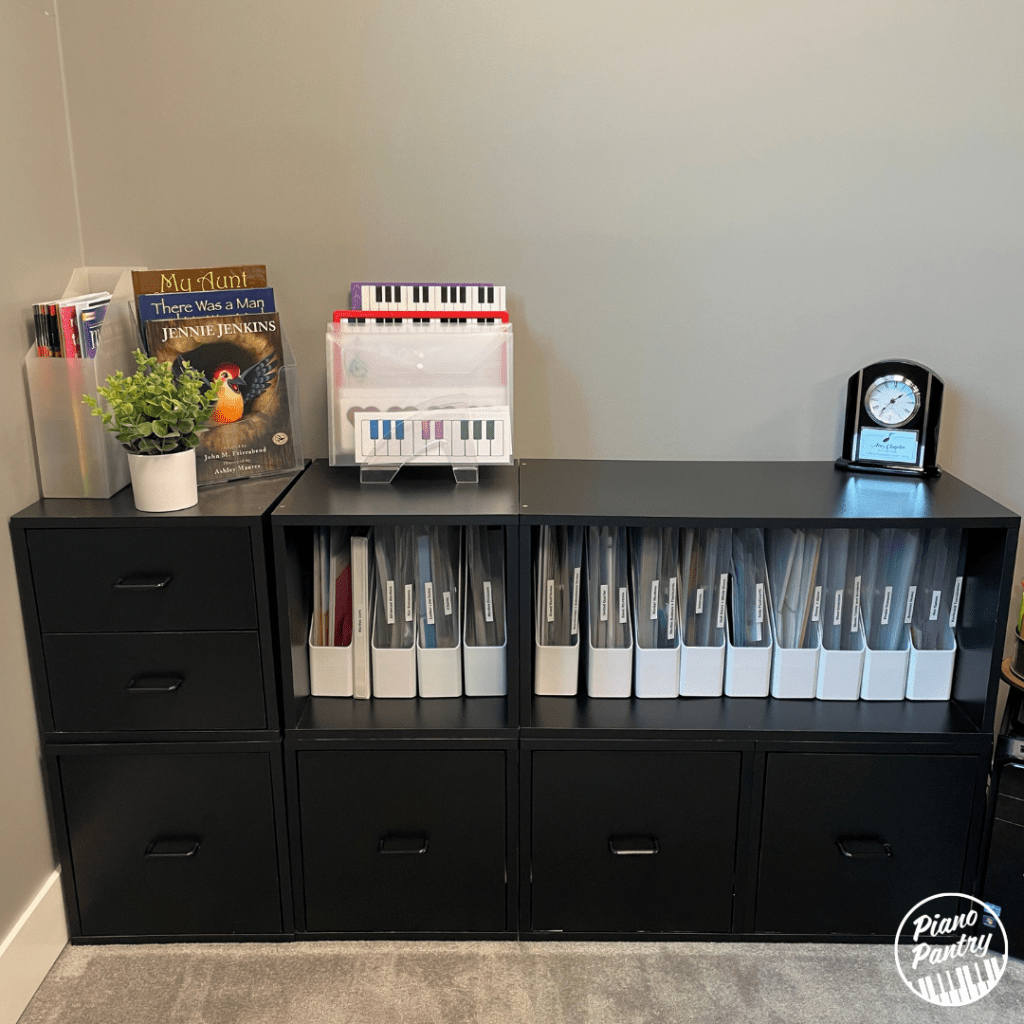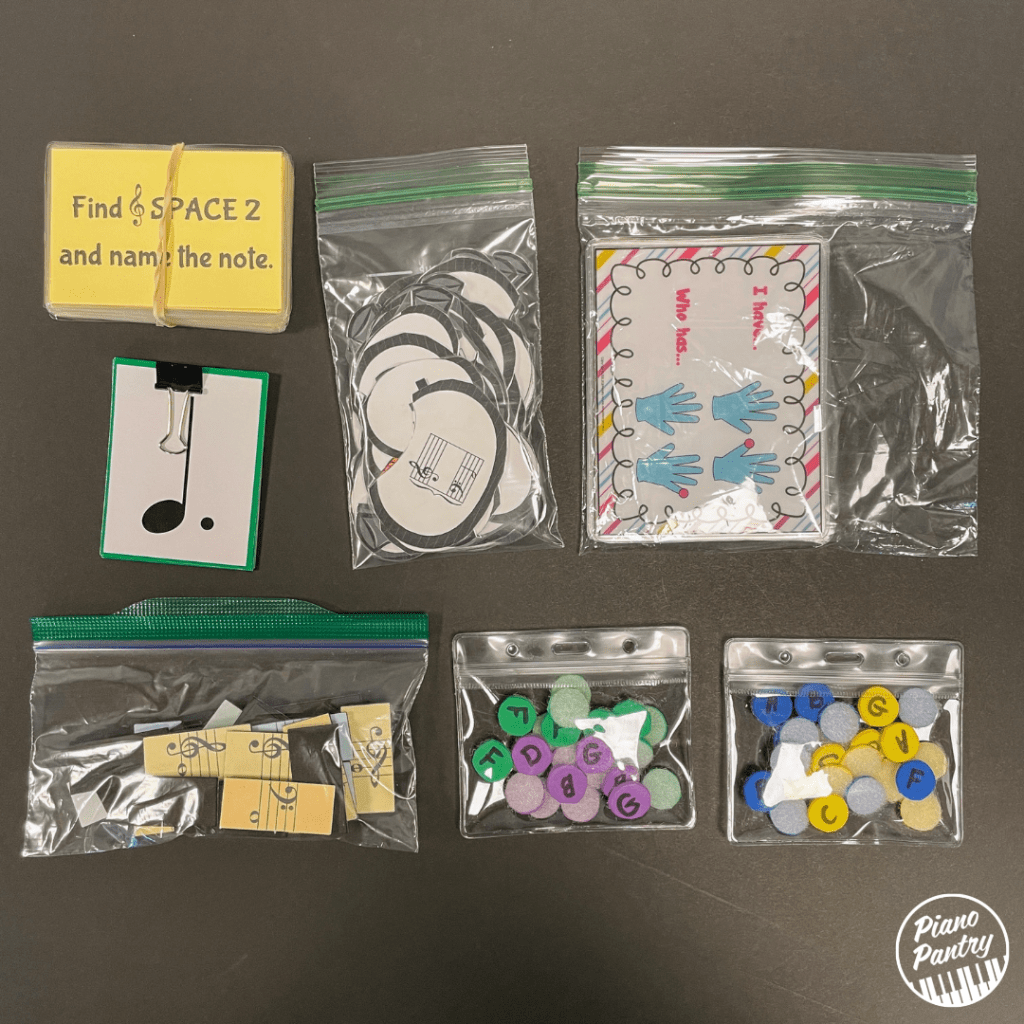
Teaching areas can be hard places to organize. Not only do we like to keep items close at hand, but if you teach a variety of levels, the number of teaching resources can easily double.
There are games, scale books, sight-reading materials, pedal extenders, dry-erase boards, game markers, technique tools, highlighters, and much more.
The great thing about organization (like many things in life) is that there’s no right or wrong way.
What we DO need in order to make it happen, though, is:
- Intention
- Action
- Some kind of (consistent) system
- Regular upkeep
- Ability to recognize when your “system” needs an update/refresh
In this post, I want to share a few different ways I have stored my own teaching games and resources over the years, as well as links to loads of other teachers’ ideas.
As you’re considering a system that works well for your space, keep these things in mind:
- Make it easily accessible – Store items in a way that will help you to both use and remember what you have
- Categorize – Group your items according to level, concept, game style (such as group games vs. solo games), and more.
- Contain – Use a variety of storage formats, including magazine holders, containers, drawers, files, and more.
I hope this post gives you lots of fresh ideas as you freshen up your own teaching space!
For more on that, listen in on episode #19 of The Piano Pantry Podcast – Spring Cleaning: It’s Time.
Get Organized
Let’s go back a bit in time. Here’s my old studio.
Years ago, I purchased a set of re-arrangeable cubes you can see in the middle of this photo from Amazon (I can’t find them anymore). I have particularly loved these because I have a variety of storage types: 4 file drawers, 1 cube that has two horizontal drawers, 1 square cube, and a double cube.

Here’s a little closer-up look. You can see the cube with two drawers much easier in this photo.

I’ve arranged them in a variety of ways over the years but 2×4 seems to be my favorite as it creates a nice work area. Here’s a look at another setup I tried out. (The bookshelf on the left was broken so I used the double cube from the Amazon set on the bottom as another shelf.)

These have worked so well over the years, I took them with me to my new studio.

In the last couple of years, I started using a lot more magazine holders. After using the cheap paper ones for years, I finally broke down and invested in these really sturdy plastic ones. LOVE – THEM.
They are a little bit narrower so items don’t fall over as easily if they’re not full. (I previously purchased a set of 8 which was much cheaper but the white is no longer available in the set of 8.)
The four bottom drawers are where I stored my games for YEARS and YEARS (yes, I made a recent change which you see further down the post).
Each drawer was labeled into 4 categories:
- Intro
- Notes
- Rhythm
- Intervals/chords/scales.
Here’s a peek inside. I used hanging files and then decorated the label of each one in a colorful way that made it more visually obvious what game was inside.
The thing I liked about using these drawers is that I could store both the games in files and use them as basic drawer storage of other teaching manipulatives.

Here are the same drawers but cleaned up a bit more.

If you would like to read more on keeping track of all of your games and manipulatives, check out this post –
Manipulatives and Games for Private and Group Instruction: A Master List
After using this same storage format for years, I got antsy to change things up for no particular reason other than I needed a change.
It took me several months off and on of trial and error, but here is what I finally came up with.

I moved all of my games out of the file folders and into plastic expandable envelopes which I first heard about from Nicola Cantan. What I struggled with at first was finding a way of knowing what was inside each envelope. My breakthrough epiphany came when I realized since they were expandable, I could print labels for the spines.
I’ve had this setup now for a couple of months and have been really happy with it. The labels don’t always stay on perfectly but they’re holding out so far. Here are some of the categories I broke my games down into:
- Keyboard Topography
- Key Names
- Finger Numbers
- Steps + Skips
- Half + Whole Steps
- Intervals
- Stem Direction
- Music Terms and Symbols
- Beginner Notes
- Accidentals + Enharmonic Notes
- Grand Staff Notes
- Ledger Lines Notes
- Note Flashcards
- Basic Rhythms
- Dotted Quarter Rhythms
- Division Rhythms
- Advanced Rhythms
- Chords
- Key Signatures
Here’s a peek at the contents of the Grand Staff envelope. I love that I can keep 8×11 size instruction pages inside along with game cards and such.

While you can see I’m currently using both rubber bands, clips, and snack-size Ziploc bags, the latter has become my favorite and I will eventually move most items into the Ziploc bags.

P.S. The four file drawers I used to keep all the games in are now used for general storage. Game dice, plastic cups for Wendy Steven’s Rhythm Cups, etc. Nothing worth looking at in there at the moment! 🙂
My “Teaching Table”

The last area I use near my teaching space is what I call my “teaching table.” I won’t go into much detail here because I already have a whole blog post about this item.
I like this rolling file drawer for reasons I mentioned earlier in this post – it gives me a variety of storage options including files, drawer, open storage, and a tabletop.
Recently, I added a new desktop organizer.

Other Teachers Sharing Their Games and Resources Organization
I’m not the only one with ideas on how to organize their teaching games and resources! Check out some of these posts for more ideas:
Clear File Folder Pockets with Plastic Button and Magazine Holders (Nicola Cantan)
Containers and Expandable Files (Heidi’s Piano Studio)
Binders with Sheet Protectors (Alexa’s Piano Studio)
Paper Folders and Magazine Holders (Susan Paradis)
Roller Cart (Megan @ Very Piano)
What’s your favorite way to store your piano games and teaching resources? Share in the comments!


This post has great timing! My birthday is Sunday and my daughter is now home after graduating from college last weekend. For my birthday, I asked her to help me organize my piano studio so I can access games and other helpful tools for lessons. Thanks for the tips! Your space looks great!
Glad you found the post helpful. Labor is a great gift idea! Ha!